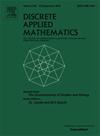Fixed-parameter algorithms for cardinality-constrained graph partitioning problems on sparse graphs
IF 1
3区 数学
Q3 MATHEMATICS, APPLIED
引用次数: 0
Abstract
For an undirected and edge-weighted graph and a vertex subset , we define a function , where is a real number, is the sum of the weights of edges having two endpoints in , and is the sum of the weights of edges having one endpoint in and the other in . Then, given an undirected and edge-weighted graph and a positive integer , Max (Min)
-Fixed Cardinality Graph Partitioning (Max (Min)
-FCGP) is the problem to find a vertex subset of size that maximizes (minimizes) . In this paper, we first show that Max
-FCGP with and Min
-FCGP with can be solved in time where is the solution size, is the degeneracy of an input graph, and is Napier’s constant. Then we consider Max (Min) Connected
-FCGP, which additionally requires the connectivity of a solution. We show that if Max (Min)
-FCGP is W[1]-hard parameterized by , so is Max (Min) Connected
-FCGP. Then, we give a -time randomized algorithm on apex-minor-free graphs. Moreover, for Max Connected
-FCGP with and Min Connected
-FCGP with , we propose a -time algorithm. Finally, we show that they admit FPT-ASs parameterized by when edge weights are constant.
稀疏图上基数约束图划分问题的固定参数算法
对于一个无向边权图G=(V,E)和一个顶点子集S∈V,定义一个函数φG(S)是(1−α)⋅w(S)+α⋅w(S,V∈S),其中α∈[0,1]是实数,w(S)是在S中有两个端点的边的权值之和,w(S,V∈S)是在S中有一个端点的边的权值之和,w(S,V∈S)是在S中有一个端点的边的权值之和,w(S,V∈S)是在V∈S中有一个端点的边的权值之和。然后,给定一个无向边权图G=(V,E)和一个正整数k, Max (Min) α-固定基数图划分(Max (Min) α-FCGP)的问题是求一个大小为k且最大(最小)φG(S)的顶点子集S≥≥φG(S)。本文首先证明了α∈[1/3,1]的Max α- fcgp和α∈[0,1/3]的Min α- fcgp可以在20 (kd+k)(e+ed)knO(1)时间内求解,其中k为解的大小,d为输入图的简并度,e为Napier常数。然后我们考虑Max (Min) Connected α-FCGP,它还要求解的连通性。我们证明了如果Max (Min) α-FCGP是W[1]-硬参数化k,那么Max (Min) Connected α-FCGP也是W[1]-硬参数化k。然后,我们给出了一个20 (klog2k)nO(1)时间的无顶点次元图随机化算法。此外,对于α∈[1/3,1]的Max Connected α- fcgp和α∈[0,1/3]的Min Connected α- fcgp,我们提出了(1+d)k2o(kd)+O(k)nO(1)时间算法。最后,我们证明了当边权不变时,它们允许用k参数化fft - ass。
本文章由计算机程序翻译,如有差异,请以英文原文为准。
求助全文
约1分钟内获得全文
求助全文
来源期刊

Discrete Applied Mathematics
数学-应用数学
CiteScore
2.30
自引率
9.10%
发文量
422
审稿时长
4.5 months
期刊介绍:
The aim of Discrete Applied Mathematics is to bring together research papers in different areas of algorithmic and applicable discrete mathematics as well as applications of combinatorial mathematics to informatics and various areas of science and technology. Contributions presented to the journal can be research papers, short notes, surveys, and possibly research problems. The "Communications" section will be devoted to the fastest possible publication of recent research results that are checked and recommended for publication by a member of the Editorial Board. The journal will also publish a limited number of book announcements as well as proceedings of conferences. These proceedings will be fully refereed and adhere to the normal standards of the journal.
Potential authors are advised to view the journal and the open calls-for-papers of special issues before submitting their manuscripts. Only high-quality, original work that is within the scope of the journal or the targeted special issue will be considered.
 求助内容:
求助内容: 应助结果提醒方式:
应助结果提醒方式:


